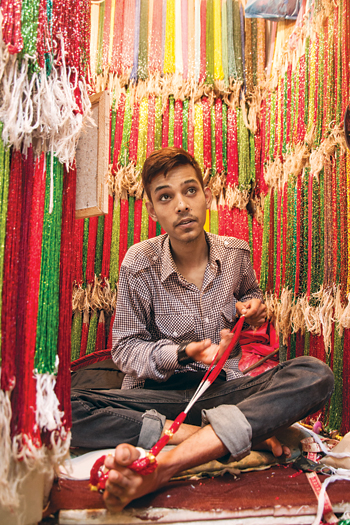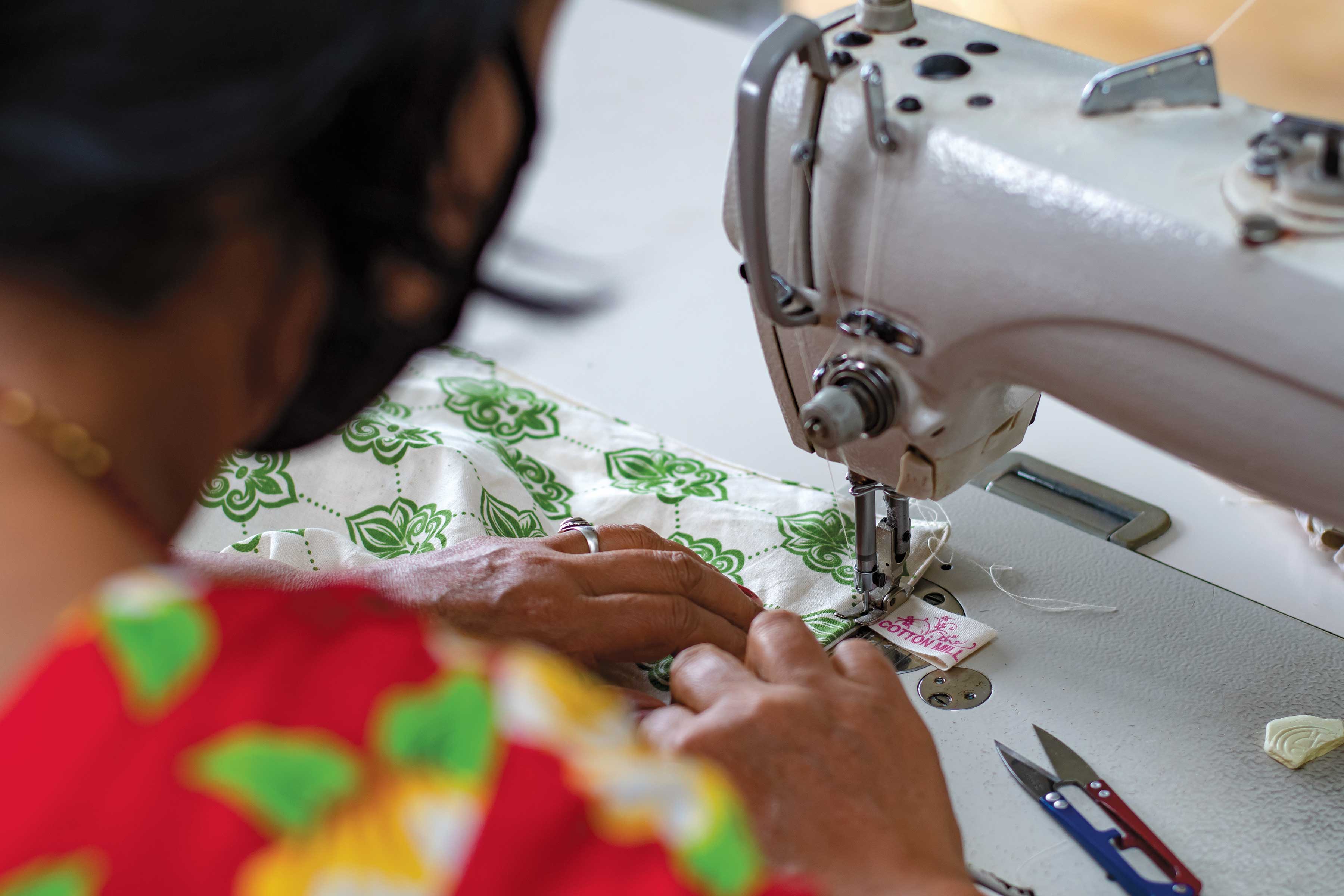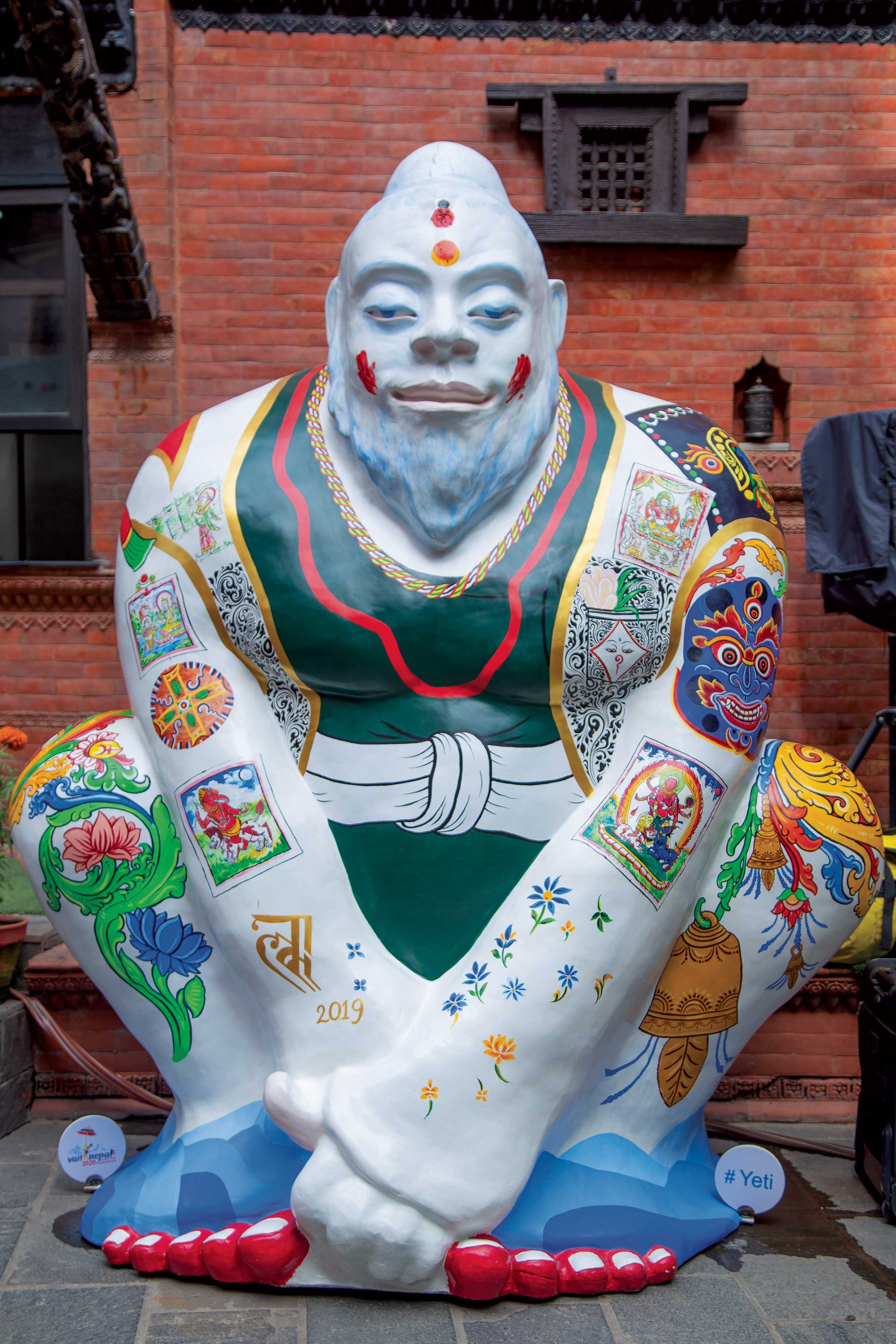There’s a small market in the heart of the capital that has an impressive heritage spanning almost 400 years. Its name is Rakhi Bazaar, although most people refer to it as Pote Bazaar, because the strands of tiny glass beads are at the heart of the matter here.

Mohammed Suleiman is fair and tall, with a straggling beard. He is probably in his mid-thirties. He sits cross-legged in his pote shop, Suleiman Stores, at Rakhi Bazaar in Indra Chowk, catering to a regular flow of customers, the majority of whom are women. He has a pleasant demeanor that contrasts quite sharply with the more matter-of-fact deportment of quite a few other pote sellers around this famous market, known popularly as Pote Bazaar, where the primary products on sale are strands of tiny glass beads (pote) in a dozen and more shiny colors.
“I think I am the ninth generation of my family to take up this business,” he says. Most of the pote sellers in the area are of Kashmiri Muslim origin. “When our ancestors migrated from Kashmir some 400 years ago, they looked around for work. Seeing that there was a demand for pote, they got into the trade,” he explains.
 To the question of why the bazaar is named Rakhi Bazaar, he makes an interesting revelation, “I believe it was originally called Iraqi Bazaar, named after some merchants from Iraq. Later, it began to be known as Rakhi Bazaar.” However, Mohammed Anish in the neighboring Mohammed Ayub Stores, immediately casts doubt on this “revelation.” According to him, the name comes from a popular soap brand called Rakhi, which was produced around this area. This slight confusion can be overlooked as it is understandable that a history spanning nearly 400 years is likely to be somewhat distorted with the passage of time.
To the question of why the bazaar is named Rakhi Bazaar, he makes an interesting revelation, “I believe it was originally called Iraqi Bazaar, named after some merchants from Iraq. Later, it began to be known as Rakhi Bazaar.” However, Mohammed Anish in the neighboring Mohammed Ayub Stores, immediately casts doubt on this “revelation.” According to him, the name comes from a popular soap brand called Rakhi, which was produced around this area. This slight confusion can be overlooked as it is understandable that a history spanning nearly 400 years is likely to be somewhat distorted with the passage of time.
It is astounding that despite being around for four centuries, this pote market has remained, more or less, the same. Well, not quite, as Mohammed Anish points out. “In years past, there were only around 15 shops here. Today, there are at least 45. My shop used to be much bigger than it is now.” According to him, all the pote sellers in Rakhi Bazaar are related to each other, and as a natural adjunct to the passing of generations, it was to be expected that divisions would follow with family members preferring to set up their own separate establishments. Actually, “establishment” is probably too presumptuous a word, since the shops are generally small in size. All these divisions have had an effect on the business, but, at the same time, most of the shops have a regular clientele, due to which business is okay as far as it goes, adds Anish.
Mohammad Anish discloses that business booms during the Teej festival and the marriage season. Here, it will be pertinent to point out that pote is an integral part of the culture for women of the Chettri and Brahmin castes. Pote are colorful tiny glass beads strung into necklaces that hold great significance in the lives of these women. The necklaces, which also have a gold ornamentation known as a tillhari, represent the married status of women. They are believed to bring good luck and ensure the long life of their husbands. And, as it happens, Teej is a festival that Chettri and Brahmin women celebrate in late August or early September for thewell being of their spouse and children. Pashupatinath Temple is the focal point of Teej in Kathmandu. During the festival, the temple is thronged by thousands of women in all their finery, with thick strands of pote necklaces around their necks and shoulders.

According to Mohammed Suleiman, red, green, and yellow pote necklaces are the traditional colors used during such festivals. “Of course, women of all ethnicities wear pote as fashionable adornments too, and different colors are also in vogue. Currently,
chocolate brown seems to be the most in demand,” he adds. A pote strand costs between Rs.40 to Rs.50. “Most women buy six to eight strands at a time,” says Suleiman. “The dharke design is the most favored during Teej and other festive occasions.” These thick necklaces, which consist of several strands and can be in plain colors or in hues of red, green, and yellow, cost between Rs.700 to Rs.1500 each. “For marriage ceremonies, women prefer the ghotu design. These are made of nytex, and are long lasting. Women are supposed to wear this on several occasions throughout their lives,” he adds.
 A stroll around the small market makes it evident that the pote bazaar is doing well; there are always plenty of customers, and business is brisk. Size doesn’t matter it seems, at least in the case of this particular market. The shops may be small, but the bazaar’s reputation as the place to buy pote more than compensates for this shortcoming. This is when the question of who makes all these sparkling necklaces arises. “There are about 15 shops here where potenecklaces can be made to order,” says Mohammed Anish. “They don’t cost much, about Rs.30 to Rs.120 per strand, even though a fair degree of skill is called for.”A big chunk of the necklaces though are made in two villages in the valley, Sunargaon and Machhegaon. Similarly, pote necklaces are also made in the central jail by inmates. “You can say that our business is providing employment to quite a large number of people,” adds Anish.
A stroll around the small market makes it evident that the pote bazaar is doing well; there are always plenty of customers, and business is brisk. Size doesn’t matter it seems, at least in the case of this particular market. The shops may be small, but the bazaar’s reputation as the place to buy pote more than compensates for this shortcoming. This is when the question of who makes all these sparkling necklaces arises. “There are about 15 shops here where potenecklaces can be made to order,” says Mohammed Anish. “They don’t cost much, about Rs.30 to Rs.120 per strand, even though a fair degree of skill is called for.”A big chunk of the necklaces though are made in two villages in the valley, Sunargaon and Machhegaon. Similarly, pote necklaces are also made in the central jail by inmates. “You can say that our business is providing employment to quite a large number of people,” adds Anish.
This particular fact is something that gives him satisfaction, and it is fitting, knowing that he and the other pote sellers in the bazaar come from a lineage that has always provided employment to people back in Kashmir. “The first Kashmiri Muslims to have come to Kathmandu were RashuJu, SubhanJu, Mustafa Ju, and Islam Ju, our forefathers,” explains Anish. ‘Ju’ is an honorary surname. We are somewhat like landlordsin Kashmir.”
Well, there’s no doubt that there’s a huge distinction between being a landlord and a pote seller, but one has to hand it to people like Mohammed Suleiman and Mohammed Anish, and all the other pote sellers in Pote Bazaar who have managed to keep an ancient heritage alive and thriving. Mohammed Anish, however, is not sure if future generations will continue the trade. “Our children might prefer to follow other professions in line with their education,” he says. “In doing so, one thing they will miss out on is the sense of community. Since we all live in separate places, having shops in the same place is such a convenience in so many ways. We get to keep each other informed about the happenings within our society and it’s also easy to arrange gatherings on special occasions.”
Fasting, feasting, singing, and dancing
Teej is a festival observed by women to invoke Lord Shiva’s blessings for marital bliss and the longevity and good health of their men folk and their families.The three-day long festival falls on or around August-end or early September every year. According to religious texts, the goddess Parbati once fasted and prayed earnestly for Lord Shiva to become her husband. Her devotion succeeded in arousing him from his state of deep meditation. He was so impressed with Parbati’s zeal that he consented to marry her. The Teej festival is held to celebrate this event.
During the festival, women, married and unmarried, and dressed almost completely in red, throng the Pashupatinath Temple in Kathmandu. The main part of the festival is the fasting, which is a rigid one, with the women not drinking even a drop of water throughout the day.Preparatory steps, however, are taken the night before to ease the ordeal: the women gorge on specially prepared rich food sent by their mothers. This is an event accompanied by a lot of singing and dancing, which carries on late into the night. The women spend the hours dancing and singing the next day as well. Teej is also an occasion for women to fraternize among themselves.
Here for good
Pratap Malla (AD 1624-74) was the ninth king of Kantipur during an era when the Kathmandu Valley was divided into three kingdoms: Kantipur, Lalitpur, and Bhaktapur. His reign saw a period of great upliftment in the culture and economy of the city. He was responsible for making a significant number of temples and monuments, including the famous Rani Pokhari (Queen’s Pond), an important landmark in Kathmandu. He is also credited with initiating important festivals such as Gai Jatra (Cow Festival) and SetoMachhindranath Jatra, which are celebrated every year with a lot of enthusiasm. His was a period that witnessed excellent relations with neighboring Tibet and India, and it was during this time that Kantipur saw the arrival of a small wave of Muslim migrants from Kashmir who, in due time, got into the bangle and pote business.
How they came to be concentrated in the small locale known as Rakhi Bazaar makes for an intriguing tale. Apparently, Indra Chowk, where the bazaar is situated, was once the bank of a river that used to flow through the area in ancient times, and which shifted direction later on. Indra Chowk became a busy business locality, but a particular site in its vicinity remained vacant because of death rituals that used to be performed there. King Pratap Malla, however, believed that this prime location was going to waste, and he thought of offering the site to the recent migrants. His suggestion was vetted by the palace priests, who advised him that the location was indeed favorable for those people who write backwards, and so, the king invited the Kashmiri Muslims to set up their trade there. That they have been doing ever since!











